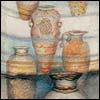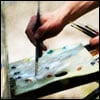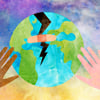The first crystal-clear memory I have of the trip up to Woodstock is when we hit 85 miles per hour on the open road in my friend Stevie’s 1968 Buick Wildcat. We were just past the New York State Thruway tollbooth in Newburgh when we raced up alongside a wildly Day-Glowed VW Bug convertible with a big white peace sign painted on its back. We flashed the V (“peace”) sign to five or six young people who couldn’t possibly fit in a car that small, but somehow did. The feeling was a pleasantly paradoxical mix of freedom and connectedness—the certainty that we were all heading towards something unknown, exciting and new; perfect strangers eloping together, escaping the known, depressing and old, the world of Richard Nixon and Richard Daley, Brezhnev and Mao, Elvis and the Rat Pack, war abroad and race riots at home.
We had purchased tickets in advance at a local head shop in Brooklyn, and we were among the first few hundred thousand young souls who were there on day one. It had rained the day before so that by the time we got to Yasgur’s farm, it was a mix of mud, manure and what would swell to about 400,000 people, all attractive not because of what they looked like, but because of what I hoped they hoped for—people who I imagined were just like me, yearning for the Age of Aquarius of which this was the dawning; people longing for a life based on peace, love, freedom, deep spirituality and respect for all humankind. This would come about only through a quantum global leap in human consciousness that would be launched by love, mind-altering chemicals and us.
That bubble burst really quickly.
After sleeping in the mud, taking some bad drugs, being too far away from the stage to enjoy the music, and witnessing some very frightening human breakdowns, I found a ride back to the city after a day-and-a-half, feeling down, dirty and depressed. For decades, I would proudly tell people that I was there, but not be very honest about what it was like.
Selling Out, Moving Up
Life’s whirlwind took me elsewhere, really fast. Less than two years later, I was a 20 year old working for the publisher of The New York Times as his office boy, living in a door-manned high rise on Manhattan’s Upper East Side—looking back at Woodstock and all that it represented as an insanity-producing exercise in communal self-indulgence and self-deception.
My shoulder-length hair was now trimmed by Jerry at Bergdorf-Goodman, my tie-dyed tank tops, Levi 501s and Frye boots supplanted by Sea Island cotton shirts, suits from Paul Stuart and shoes from Church’s. Opiated hashish and LSD, having permanently burned out the bodies and brains of some very close friends, were recognized as the very, very dangerous drugs that they were (and still are), and were replaced by far less crazy-making intoxicants like Johnny Walker Black on the rocks and Stolichnaya gimlets. Make love, not war was replaced by a new mantra: Life is a game in which he who dies with the most toys wins.
That didn’t work out so well either.

Big-City Burnout
By the summer of 1985, a decade-and-a-half of the fast life in the big city had taken its toll on my relationships, my finances and my health, and I was looking for something—anything—different. When I saw an ad in The Village Voice for an “Encounter with Chabad” weekend in Crown Heights, I thought I’d give it a try. Although I grew up in Brooklyn, I had never, not even once, had a conversation with an Orthodox Jew—let alone a Chassidic Jew—about anything substantive. I showed up in Crown Heights so clueless that it didn’t occur to me that I should bring a kippah with me (not that I owned one). And I found something very different than anything that I had expected.
There I found men and women, Chassidic Jews, of all people, from all kinds of backgrounds. A few were college-educated, but most had families that were Chassidic for hundreds of years. But just about all of them were in some very important ways kindred spirits to my younger self—still possessing a deep belief in the potential of human goodness and the possibility of a world transformed, not just longing for, but working towards that quantum leap in global consciousness that my generation had so deeply hoped for and abandoned.
Fascinated by the people I met that weekend, I soon decided to study in a yeshivah while continuing to work at the Times. I soon learned about some deep spiritual concepts that explained the world in which I live and my purpose in it. Two key ones presented to me in my study of Tanya and Likkutei Torah were the primordial worlds or dimensions of Tohu and Tikkun.

From ‘Tohu’ to ‘Tikkun’
I learned how perfect, holy souls like yours and mine are sent down into an imperfect, unholy world in order to bring “the orot of Tohu into the keilim of Tikkun” (the “lights” of Tohu into the “vessels” of Tikkun). That means, in short, that we’re all here on this planet to harness the passionate, chaotic, destructive energy of a ruptured primordial world that usually manifests itself in all kinds of physically and spiritually damaging ways. We need to channel that raw, intense energy through G‑dly thought, communication and behavior defined and bounded by Torah and halachah, the deeply detailed Divine guidance for a life well-lived.
The goal is to build a world that will be a dwelling place for G‑d and humankind, filled with eternal, Divine consciousness. No drugs necessary.
All things have their root on high, I was taught. True, the psychedelics, the hippiness, the free love—in practice, these all proved to be destructive, even deadly, emanations of the unbridled light of Tohu. Nevertheless, at their essence they contain Divine sparks of powerful energy, meant to be redeemed and used for holiness. And I had found the means to do that, by safely channeling that energy into the bounds of the vessels of Tikkun—through the mindful and heartfelt study of Torah and the passionate, joyous performance of mitzvahs.
My own journey took me from Crown Heights to Monsey, N.Y., and 11 years ago, to Israel. Fifty years after Woodstock, sitting here in Jerusalem on Tisha B’Av, fasting, without food or water for the past 24 hours, reflecting on the past and the future, the world’s and my own, with 35 years of Chassidic study and practice behind me, I can see more clearly than ever how the Rebbe—Rabbi Menachem M. Schneerson, of righteous memory—sought to harness my generation’s raw, youthful energy and hope for a better future and channel it into a global revolution of goodness, kindness and G‑dliness. He knew it was possible, and he showed us how to do it.
The Rebbe taught me to slowly but surely discover a little bit more every day about myself, about the world I live in, and about G‑d. To nurture whatever I am most passionate about, and figure out how to use it for the benefit of others. To be curious about how G‑d wants me to live in the world. To find out how to engage in a well-lived life by studying the written and oral Torah—life’s blueprint and instruction manual. To set up a fixed time for study, however modest, every morning and every night. To focus on giving to others, not on getting for myself. To find mentors who I admire and trust. To share what I’ve learned and experienced. To discover the sublime, incomparable joy of learning Torah in depth as an end in itself. To pray sincerely and give of myself generously. To find a congregation, a community of people who I like and identify with, and join humankind everywhere in a revolution in behavior and consciousness that, with G‑d’s help, will achieve a critical mass of goodness and transform this fractured world of ours into one that is forever filled with love, respect, compassion and harmony in what we call the Messianic Era.
It’s an era we have not fully entered yet, but despite some appearances, we’re getting closer and closer to its complete and final unfolding every day.










Join the Discussion